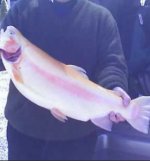Without a biological study, none of us know the answer, so I'm not sure how you guys can be so certain of the correct one. I'm simply stating an opinion, like anyone else on this topic.
My only "evidence" is anecdotal based on a stream I fish regularly. I remember when wild browns were rare there. Now? They're almost the entire makeup of the stream.
The state started stocking brood stock in this stream years ago. Seems logical to me that when you continually stock 3+ year old fish that are used for spawning for 30 some years, there is going to be natural reproduction from those fish. That mixed with an existing population of wild fish that are effective at reproducing accelerates the quantity of wild fish.
I personally do see stocked fish genetics (spot patterns) in wild fish. Especially from the stream above. They're mixed with browns that are clearly several more generations old or from different genetics/older ancestors. Regardless, from my years of experience there, all the wild fish are from stocks that are no older than maybe 40 or 50 years (IMO).
I think the river system plays a huge role in this too. Places where the stream is highly conductive to natural reproduction vs places where, without continued stocking, the population wouldn't be anywhere close to what it is.
Again, I'm not saying
every brown trout in pa is only 1 or 2 generations removed from a stocked fish. There's likely a huge variance in generational separation from the stocked ancestor.
And comparing Montana to PA is ridiculous. Had they stopped stocking browns in PA in 1955, we'd
probably (I don't know of sure. I'm speculating) have 1/8 the population of wild browns.
None of this has anything to do w/ the coveted "great banana trout" though.






